Jie Ding
An Outlook on the Opportunities and Challenges of Multi-Agent AI Systems
May 23, 2025Abstract:Multi-agent AI systems (MAS) offer a promising framework for distributed intelligence, enabling collaborative reasoning, planning, and decision-making across autonomous agents. This paper provides a systematic outlook on the current opportunities and challenges of MAS, drawing insights from recent advances in large language models (LLMs), federated optimization, and human-AI interaction. We formalize key concepts including agent topology, coordination protocols, and shared objectives, and identify major risks such as dependency, misalignment, and vulnerabilities arising from training data overlap. Through a biologically inspired simulation and comprehensive theoretical framing, we highlight critical pathways for developing robust, scalable, and secure MAS in real-world settings.
Ice Cream Doesn't Cause Drowning: Benchmarking LLMs Against Statistical Pitfalls in Causal Inference
May 19, 2025Abstract:Reliable causal inference is essential for making decisions in high-stakes areas like medicine, economics, and public policy. However, it remains unclear whether large language models (LLMs) can handle rigorous and trustworthy statistical causal inference. Current benchmarks usually involve simplified tasks. For example, these tasks might only ask LLMs to identify semantic causal relationships or draw conclusions directly from raw data. As a result, models may overlook important statistical pitfalls, such as Simpson's paradox or selection bias. This oversight limits the applicability of LLMs in the real world. To address these limitations, we propose CausalPitfalls, a comprehensive benchmark designed to rigorously evaluate the capability of LLMs in overcoming common causal inference pitfalls. Our benchmark features structured challenges across multiple difficulty levels, each paired with grading rubrics. This approach allows us to quantitatively measure both causal reasoning capabilities and the reliability of LLMs' responses. We evaluate models using two protocols: (1) direct prompting, which assesses intrinsic causal reasoning, and (2) code-assisted prompting, where models generate executable code for explicit statistical analysis. Additionally, we validate the effectiveness of this judge by comparing its scoring with assessments from human experts. Our results reveal significant limitations in current LLMs when performing statistical causal inference. The CausalPitfalls benchmark provides essential guidance and quantitative metrics to advance the development of trustworthy causal reasoning systems.
Safety Aware Task Planning via Large Language Models in Robotics
Mar 19, 2025Abstract:The integration of large language models (LLMs) into robotic task planning has unlocked better reasoning capabilities for complex, long-horizon workflows. However, ensuring safety in LLM-driven plans remains a critical challenge, as these models often prioritize task completion over risk mitigation. This paper introduces SAFER (Safety-Aware Framework for Execution in Robotics), a multi-LLM framework designed to embed safety awareness into robotic task planning. SAFER employs a Safety Agent that operates alongside the primary task planner, providing safety feedback. Additionally, we introduce LLM-as-a-Judge, a novel metric leveraging LLMs as evaluators to quantify safety violations within generated task plans. Our framework integrates safety feedback at multiple stages of execution, enabling real-time risk assessment, proactive error correction, and transparent safety evaluation. We also integrate a control framework using Control Barrier Functions (CBFs) to ensure safety guarantees within SAFER's task planning. We evaluated SAFER against state-of-the-art LLM planners on complex long-horizon tasks involving heterogeneous robotic agents, demonstrating its effectiveness in reducing safety violations while maintaining task efficiency. We also verify the task planner and safety planner through actual hardware experiments involving multiple robots and a human.
Model Privacy: A Unified Framework to Understand Model Stealing Attacks and Defenses
Feb 21, 2025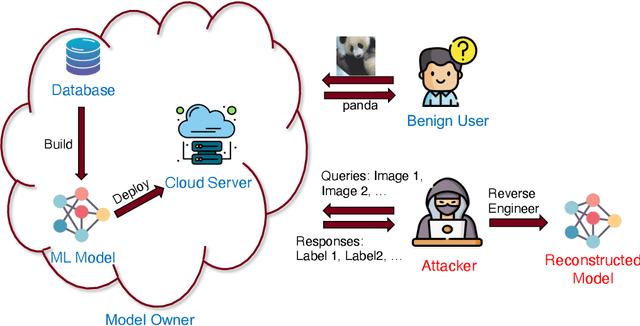
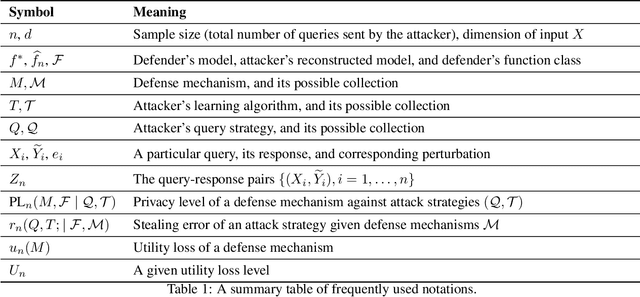
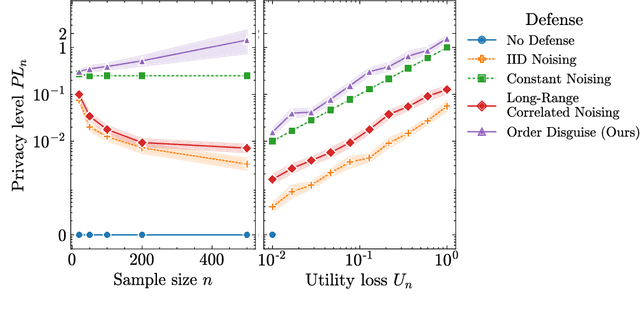

Abstract:The use of machine learning (ML) has become increasingly prevalent in various domains, highlighting the importance of understanding and ensuring its safety. One pressing concern is the vulnerability of ML applications to model stealing attacks. These attacks involve adversaries attempting to recover a learned model through limited query-response interactions, such as those found in cloud-based services or on-chip artificial intelligence interfaces. While existing literature proposes various attack and defense strategies, these often lack a theoretical foundation and standardized evaluation criteria. In response, this work presents a framework called ``Model Privacy'', providing a foundation for comprehensively analyzing model stealing attacks and defenses. We establish a rigorous formulation for the threat model and objectives, propose methods to quantify the goodness of attack and defense strategies, and analyze the fundamental tradeoffs between utility and privacy in ML models. Our developed theory offers valuable insights into enhancing the security of ML models, especially highlighting the importance of the attack-specific structure of perturbations for effective defenses. We demonstrate the application of model privacy from the defender's perspective through various learning scenarios. Extensive experiments corroborate the insights and the effectiveness of defense mechanisms developed under the proposed framework.
Probe Pruning: Accelerating LLMs through Dynamic Pruning via Model-Probing
Feb 21, 2025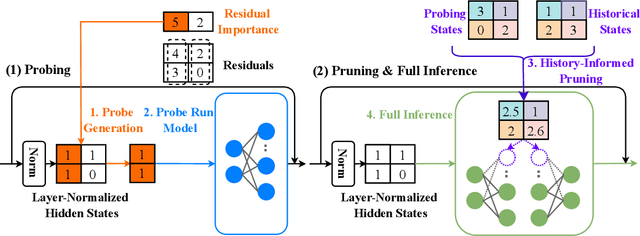



Abstract:We introduce Probe Pruning (PP), a novel framework for online, dynamic, structured pruning of Large Language Models (LLMs) applied in a batch-wise manner. PP leverages the insight that not all samples and tokens contribute equally to the model's output, and probing a small portion of each batch effectively identifies crucial weights, enabling tailored dynamic pruning for different batches. It comprises three main stages: probing, history-informed pruning, and full inference. In the probing stage, PP selects a small yet crucial set of hidden states, based on residual importance, to run a few model layers ahead. During the history-informed pruning stage, PP strategically integrates the probing states with historical states. Subsequently, it structurally prunes weights based on the integrated states and the PP importance score, a metric developed specifically to assess the importance of each weight channel in maintaining performance. In the final stage, full inference is conducted on the remaining weights. A major advantage of PP is its compatibility with existing models, as it operates without requiring additional neural network modules or fine-tuning. Comprehensive evaluations of PP on LLaMA-2/3 and OPT models reveal that even minimal probing-using just 1.5% of FLOPs-can substantially enhance the efficiency of structured pruning of LLMs. For instance, when evaluated on LLaMA-2-7B with WikiText2, PP achieves a 2.56 times lower ratio of performance degradation per unit of runtime reduction compared to the state-of-the-art method at a 40% pruning ratio. Our code is available at https://github.com/Qi-Le1/Probe_Pruning.
Unraveling the Gradient Descent Dynamics of Transformers
Nov 12, 2024



Abstract:While the Transformer architecture has achieved remarkable success across various domains, a thorough theoretical foundation explaining its optimization dynamics is yet to be fully developed. In this study, we aim to bridge this understanding gap by answering the following two core questions: (1) Which types of Transformer architectures allow Gradient Descent (GD) to achieve guaranteed convergence? and (2) Under what initial conditions and architectural specifics does the Transformer achieve rapid convergence during training? By analyzing the loss landscape of a single Transformer layer using Softmax and Gaussian attention kernels, our work provides concrete answers to these questions. Our findings demonstrate that, with appropriate weight initialization, GD can train a Transformer model (with either kernel type) to achieve a global optimal solution, especially when the input embedding dimension is large. Nonetheless, certain scenarios highlight potential pitfalls: training a Transformer using the Softmax attention kernel may sometimes lead to suboptimal local solutions. In contrast, the Gaussian attention kernel exhibits a much favorable behavior. Our empirical study further validate the theoretical findings.
MAP: Multi-Human-Value Alignment Palette
Oct 24, 2024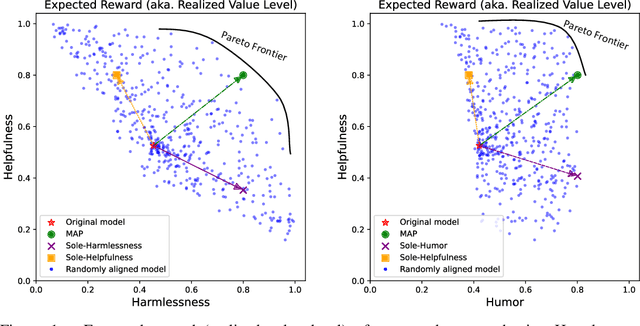
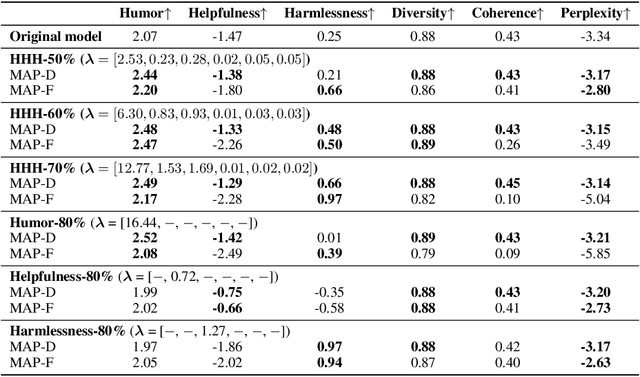

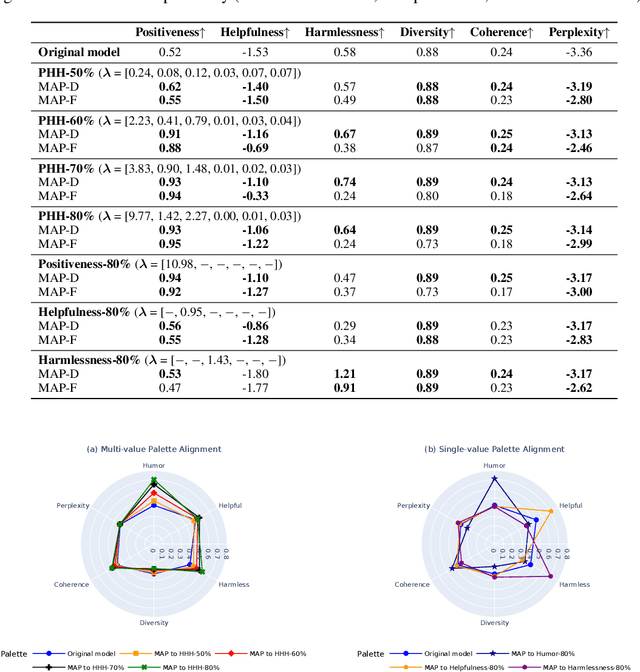
Abstract:Ensuring that generative AI systems align with human values is essential but challenging, especially when considering multiple human values and their potential trade-offs. Since human values can be personalized and dynamically change over time, the desirable levels of value alignment vary across different ethnic groups, industry sectors, and user cohorts. Within existing frameworks, it is hard to define human values and align AI systems accordingly across different directions simultaneously, such as harmlessness, helpfulness, and positiveness. To address this, we develop a novel, first-principle approach called Multi-Human-Value Alignment Palette (MAP), which navigates the alignment across multiple human values in a structured and reliable way. MAP formulates the alignment problem as an optimization task with user-defined constraints, which define human value targets. It can be efficiently solved via a primal-dual approach, which determines whether a user-defined alignment target is achievable and how to achieve it. We conduct a detailed theoretical analysis of MAP by quantifying the trade-offs between values, the sensitivity to constraints, the fundamental connection between multi-value alignment and sequential alignment, and proving that linear weighted rewards are sufficient for multi-value alignment. Extensive experiments demonstrate MAP's ability to align multiple values in a principled manner while delivering strong empirical performance across various tasks.
Drift to Remember
Sep 21, 2024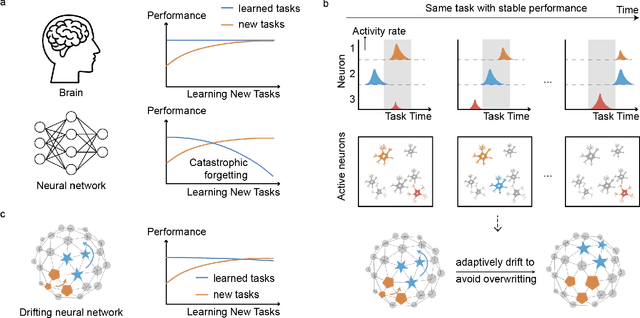
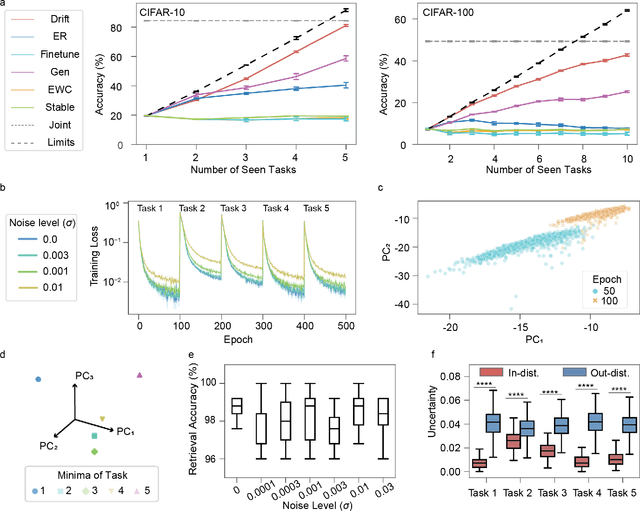
Abstract:Lifelong learning in artificial intelligence (AI) aims to mimic the biological brain's ability to continuously learn and retain knowledge, yet it faces challenges such as catastrophic forgetting. Recent neuroscience research suggests that neural activity in biological systems undergoes representational drift, where neural responses evolve over time, even with consistent inputs and tasks. We hypothesize that representational drift can alleviate catastrophic forgetting in AI during new task acquisition. To test this, we introduce DriftNet, a network designed to constantly explore various local minima in the loss landscape while dynamically retrieving relevant tasks. This approach ensures efficient integration of new information and preserves existing knowledge. Experimental studies in image classification and natural language processing demonstrate that DriftNet outperforms existing models in lifelong learning. Importantly, DriftNet is scalable in handling a sequence of tasks such as sentiment analysis and question answering using large language models (LLMs) with billions of parameters on a single Nvidia A100 GPU. DriftNet efficiently updates LLMs using only new data, avoiding the need for full dataset retraining. Tested on GPT-2 and RoBERTa, DriftNet is a robust, cost-effective solution for lifelong learning in LLMs. This study not only advances AI systems to emulate biological learning, but also provides insights into the adaptive mechanisms of biological neural systems, deepening our understanding of lifelong learning in nature.
DynamicFL: Federated Learning with Dynamic Communication Resource Allocation
Sep 08, 2024



Abstract:Federated Learning (FL) is a collaborative machine learning framework that allows multiple users to train models utilizing their local data in a distributed manner. However, considerable statistical heterogeneity in local data across devices often leads to suboptimal model performance compared with independently and identically distributed (IID) data scenarios. In this paper, we introduce DynamicFL, a new FL framework that investigates the trade-offs between global model performance and communication costs for two widely adopted FL methods: Federated Stochastic Gradient Descent (FedSGD) and Federated Averaging (FedAvg). Our approach allocates diverse communication resources to clients based on their data statistical heterogeneity, considering communication resource constraints, and attains substantial performance enhancements compared to uniform communication resource allocation. Notably, our method bridges the gap between FedSGD and FedAvg, providing a flexible framework leveraging communication heterogeneity to address statistical heterogeneity in FL. Through extensive experiments, we demonstrate that DynamicFL surpasses current state-of-the-art methods with up to a 10% increase in model accuracy, demonstrating its adaptability and effectiveness in tackling data statistical heterogeneity challenges.
Drop the beat! Freestyler for Accompaniment Conditioned Rapping Voice Generation
Aug 28, 2024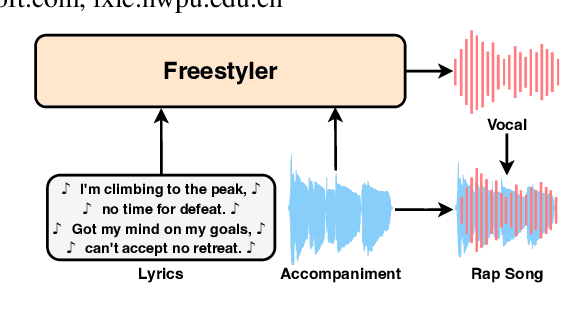

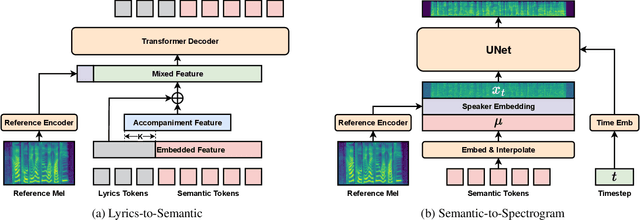

Abstract:Rap, a prominent genre of vocal performance, remains underexplored in vocal generation. General vocal synthesis depends on precise note and duration inputs, requiring users to have related musical knowledge, which limits flexibility. In contrast, rap typically features simpler melodies, with a core focus on a strong rhythmic sense that harmonizes with accompanying beats. In this paper, we propose Freestyler, the first system that generates rapping vocals directly from lyrics and accompaniment inputs. Freestyler utilizes language model-based token generation, followed by a conditional flow matching model to produce spectrograms and a neural vocoder to restore audio. It allows a 3-second prompt to enable zero-shot timbre control. Due to the scarcity of publicly available rap datasets, we also present RapBank, a rap song dataset collected from the internet, alongside a meticulously designed processing pipeline. Experimental results show that Freestyler produces high-quality rapping voice generation with enhanced naturalness and strong alignment with accompanying beats, both stylistically and rhythmically.
 Add to Chrome
Add to Chrome Add to Firefox
Add to Firefox Add to Edge
Add to Edge